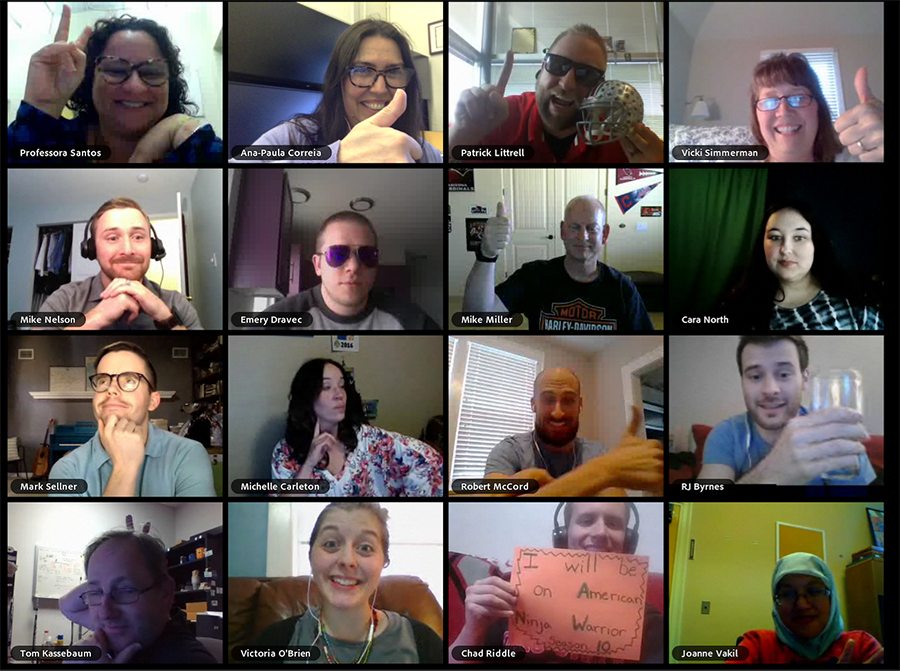
College of Education and Human Ecology researchers try to make online programs "authentic as possible."
Learning Technologies team fine-tunes e-teaching
In this age of innovation, online learning was supposed to revolutionize higher education and job training. Easy to access, it’s more flexible for nontraditional students, who can log on anytime and anywhere Wi-Fi is available. And as technology has advanced, it’s become far more reliable.
There’s just one hitch. In the absence of physical spaces and face-to-face interaction, online classes can be, well, dull.
“Those text-based, text-driven online classes … boring after boring after boring. They are not going to survive in this market,” said Ana-Paula Correia, associate professor of learning technologies and founder of the university’s Learning and Experience Design research group.
Correia and her colleagues in the College of Education and Human Ecology’s Learning Technologies program are on a mission to rescue online learners from the boredom. “I think the students should demand better courses. We are preparing to do that,” she said.
Researchers in the program confirm what any zoned-out student knows: Learning online is not the same as it is in the classroom.
“If you want to watch lectures, you might as well take a face-to-face class. An online class has to have unique features. It needs to have multiple sources of engagement,” said Kui Xie, Cyphert Distinguished Professor and founder of Ohio State’s Research Laboratory for Digital Learning.
His and others’ research has resulted in pedagogy that is fine-tuned for online learning. In the competitive online Master of Learning Technology degree program, instructors strive to create a cohesive community of learners.
Step one: Make learning more social and personalized
“I want to make classes as authentic as possible,” Correia said.
Students in her Applied Instructional Design course introduce themselves on discussion boards using video, audio, still images and text. A “get to know each other” board contains posts ranging from pet photos to a discussion about bread-making. “Allison did a very formal introduction video. I appreciate it. Some are more informal and include fun facts. Chad, for example, trains to be an American Ninja Warrior.”
By the second week of class, the students and instructor know each other better than they would in a physical classroom setting.

Step two: Make students love the learning
“The challenge is, how do you build experiential e-learning events?” Correia said. Her research explores ways to design meaningful, productive online experiences that facilitate deep learning.
As in brick-and-mortar classes, students explore content through a curriculum and readings. But Correia limits recorded lectures. Instead, students sign up to explore topics and lead the discussions. “That week I give them the mic,” she said.
“I work with the students on designing the discussion. Some use video, some use memes — all kinds of different strategies to create that discussion. Some use excerpts from popular movies. I have many, many examples.”
Xie’s research shows that students are motivated both extrinsically (by grades, praise and rewards) and intrinsically (by individual interests and enjoyment in projects). “Motivation is a factor that really drives engagement,” he said.
So, Associate Professor Rick Voithofer pushes students to put their own spin on projects. “I always try to encourage students to think of a practicum (centered on) something that they feel passionately about. People put the most creativity and effort into things that they’re passionate about and they feel excitement about.”
He might ask his students: How does technology make us think about knowing and knowledge? Using an online, asynchronous (not in real time) discussion platform, students post stories that creatively answer the prompt. They use images and record themselves using video, audio and text. Classmates respond.
Xie’s students use a similar method to create a new Ohio State logo. Correia’s students do virtual internships, conducting short-term instructional design projects for local organizations.
The process is collaborative and yet individualistic. It engages students cognitively but also encourages them to invest emotionally in the learning.
Step three: Provide flexibility, and be there
Correia’s students are “talented and successful” adult learners, mostly full-time professionals. “They have a lot to offer,” she said. Whether they’re participating at 2 a.m. or 3 p.m., the format must be flexible.
“Online discussion is a big issue when you teach online, because the maintenance of it is 24-hours, seven days a week,” she said.
Because students are participating after a hard day of work or on weekends, they need to know that their instructor sees them as individuals and is paying attention to their learning, said Voithofer. That means extra work on the part of the professor.
“If (students) are putting in this effort, and feel like nobody’s home, or engaging them, then the motivation goes down and the engagement goes down, and also the passion for learning,” he said.
Engagement — among students, the instructor and with the material — is key. Moreover, Xie’s research proves that this type of learning sticks. These online courses aren’t about regurgitating facts.
“Retaining information is one type of learning outcome, but in my research, I care more than just about retrieving the information,” he said. “I care more about how students can create new information from the information they have received.”
“I don’t want to be a messenger. I think that's a better way of learning. It’s more meaningful to them.”
No-yawn e-learning
College of Education and Human Ecology researchers and graduates support expertise in online teaching for both university and outside educators.
- Resources are available to Ohio State lecturers and faculty at the Office of Distance Education and e-Learning.
- Kui Xie's research findings are available at the Research Laboratory for Digital Learning.
- Blogs, research findings and scholarly work are available for review at the Learning and Experience Design Research Group, founded and directed by Ana-Paula Correia.

